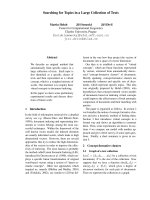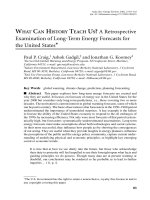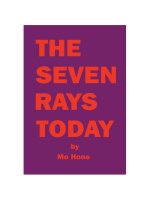The Marketing Data Box - A QUARTERLY COLLECTION OF PRACTICAL MARKETING TOOLS READY FOR PROFESSIONAL USE doc
Bạn đang xem bản rút gọn của tài liệu. Xem và tải ngay bản đầy đủ của tài liệu tại đây (3.3 MB, 65 trang )
D ATA I N S I G H T S
A QUARTERLY COLLECTIO N OF PRACTI CAL
MARKETING TOOLS READY FO R
PROFESSI ONAL USE
S P O N S O R E D B Y :
The Marketing
Data Box
trends • insights • analysis • charts • ready to use • easy to share
The Marketing Data Box
2
The charts in this collection are ready to use, download, format, and otherwise support your
marketing goals. Feel free to share the whole presentation or any slide, with your colleagues and
business partners, but please preserve credits to our sponsor, HubSpot, our research partners who
provide the source data, and our links to MarketingCharts.com.
“The Marketing Data Box” is part of Watershed Publishing’s Data Insights series featuring news,
data and research. The quarterly collection supplies the busy marketing professional with a time-saving
collection of research and facts, in the form of charts and Excel documents, in order to make the
knowledge demands of daily marketing an easier task. Our data comes from major data partners and
captures essential marketing data over the short term for a fast, easy glance at trends.
D ATA I N S I G H T S
The Marketing Data Box
3
By many accounts, the economy is on an upswing: Major advertisers increased spending by about 6%, but
perhaps more importantly, roughly 40% of Americans indicated that the economy is “getting better.”
This is important news for marketers of all stripes, since it impacts the way they will approach their
marketing efforts.
But that’s just one of many practical marketing facts that have been collected in “The Marketing Data Box.”
In this issue here are just a few facts you’ll discover:
•The benefits and consequences of social media to US Adults
•Whether Americans are willing or not to pay for online news
•The average cost per lead for outbound vs. inbound marketing
•The percentage of mobile users that own smartphones
•What activity dominates mobile internet time (and it’s not social networking)
•Ecommerce growth rates
•What percent of US population search online for health information, and where they are
most likely to go
•The TV programming that will make your ads more likely to be thought of as trustworthy
There are 65 charts on 54 data slides in this issue – as well as insightful analysis you can share with your
blog or newsletter subscribers, and fellow marketing and sales team members. As a marketer, how can you
resist?
Enjoy,
The HubSpot Team
Charts inside…
Charts inside…
Media & Advertising
Top 10 Advertisers Spend Trend
Ad Spend for Television Media
Ad Spend for Radio Media
Ad Spend for Newspaper Media
Ad Spend for Magazine Media
News Sources, 2001-2010
News Audience
Revenue by News Source
Top 10 Print Media Websites
Spending & Channels
Marketing Media, B2B v. B2C
Marketing Metrics, B2B v. B2C
Types of Email Sent, B2B v. B2C
Average Cost per Lead
Above Average Cost per Lead
Below Average Cost per Lead
Cost per Click: Yahoo-Bing, Google
Top 10 Ad Focus Properties
Google & Facebook Use
Benefits of Social Media
Consequences of Social Media
Top 10 Social Network Sites
Online Video & Mobile
Top 10 Video Multimedia Sites
Top 10 Video Sites by Ads Viewed
Smartphone Penetration
SMS Sent/Received per Month
Mobile Internet Time by Category
Top 10 Mobile Phone Sites
Top 10 Television Sites
TV Programs for Ad-based Purchases
Retail & Consumer Goods
Economic Confidence Index
Outlook for Economy in 2011
Top Investment/Finance Sites
Online Retail Spending
Department Store Advertisers
Youth Influence and Purchases
Number of Online Content Buys
Lifestyle & Community
Health Research by Age
Health Information Sites
Top 10 Politics Sites
Perception of Year Ahead
Top 10 Real Estate Sites
Community-based Organizations
About HubSpot
Our Data Partners
Sponsorship Information
Media & Advertising
Top 10 Advertisers Spend Trend
Ad Spend for Television Media
Ad Spend for Radio Media
Ad Spend for Newspaper Media
Ad Spend for Magazine Media
News Sources, 2001-2010
News Audience
Revenue by News Source
Top 10 Print Media Websites
The Marketing Data Box
6
$3,123.9
$2,130.7
$2,092.8
$1,823.2
$1,368.4
$1,228.7
$1,193.6
$1,139.7
$1,132.2
$1,112.4
$2,653.8
$2,157.9 $1,867.0 $2,149.7 $1,238.8 $1,391.5 $1,200.0 $1,232.6 $1,019.0 $852.0
Procter
& Gamble
General
Motors
AT&T Verizon News Corp Pfizer Inc Time Warner Johnson
& Johnson
Ford Motor
Co.
L'Oreal
2009 2010
2011: $173 Billion in Revenues
Top 10 Advertisers Spend Trend
2009 v. 2010, US$ Millions
Source: Kantar Media
Spending among the 10 largest advertisers increased 5.9% to
$11.91 billion in the first nine months of 2010. However, total
advertising levels remain below those observed in the recent
peak (pre-recession) year of 2006, with researchers
projecting the industry’s size likely to equate to $173 billion in
revenues this year.
Large advertisers back to spending in 2010
Large advertisers back to spending in 2010
Large advertisers back to spending in 2010
The Marketing Data Box
7
TV Media Best Y-o-Y Growth
Strong growth in television media
How did the spending flow? According to Kantar
Media reports, of the major media channels, the
TV sector reported the best year-over-year ad
expenditure growth rate in 2010 (10.3%). Within
the sector, extremely strong spot TV growth
(24.2%) and impressive growth in Spanish
language cushioned enough for the 2.8%
contraction in large-scale national syndicated
campaigns.
10.3%
5.3%
9.8%
24.2%
10.7%
-2.8%
Television
media total
Network TV Cable TV Spot TV Spanish
Language TV
Syndication –
National
Ad Spend for Television Media
2009 v. 2010, % change
Source: Kantar Media
The Marketing Data Box
8
Ad Spend for Radio Up 7%
Strong showing for radio
Radio has been hanging tough in these years,
holding audience, and attracting advertising.
Radio media spending increased 7.6% led by
national spot radio, with an 18.6% increase.
Radio has fared well overall in terms of
listenership, too. Network radio maintained its
reach to about 189.7 million listeners, or nearly
74% of Americans age 12 and up, according to
Arbitron RADAR 107.
7.6%
4.9%
18.6%
2.2%
Radio media total Local radio National spot radio Network radio
Ad Spend for Radio Media
2009 v. 2010, % change
Source: Kantar Media
The Marketing Data Box
9
Ad Spend for Newspaper Media
2009 v. 2010, % change
Source: Kantar Media
Newspapers: Negative and Slow
Newspapers lose audience, revenue
There is not much good news for print
advertising revenue stream. MagnaGlobal
analysis indicates reported totals are held back
by deep structural weakness in printed media,
which weakens with every passing quarter.
MagnaGlobal predicts newspapers, magazines,
directories and direct mail will likely decline by
2.9% during 2011.
-3.5%
-4.6%
2.7%
2.0%
Newspaper media total
Local newspapers
National newspapers
Spanish-language newspapers
Newspapers lose audience, revenue
The Marketing Data Box
10
Sunday Mags are Bright Spot
Sunday magazines show some growth
Data from The Nielsen Company, also found
that in terms of ad spending, print media
overall (national and local magazines,
newspapers, Sunday supplements and B2B)
was flat, not picking up on the energy of other
media. However, national Sunday supplements
received a significant uptick with 20.5% growth
from last year. (Local Sunday supplements fell
about 13%.) National magazines were also up
7.4%.
2.90%
3.30%
-1.20%
4.60%
0.90%
Magazine media total
Consumer Magazines
B-to-B Magazines
Sunday Magazines
Sunday magazines show some growth
Ad Spend for Magazine Media
2009 v. 2010, % change
Source: Kantar Media
The Marketing Data Box
11
Consumer News Sources, 2001-2010
Percent (%) of adults
Source: Pew Research
Online News Audience Up 17%
An increasing share of the US news audience
turned to the internet in 2010, according to a new
report from the Pew Project for Excellence in
Journalism. Data from “State of the News Media
2011″ indicates in 2010, every news platform
except for the internet saw audiences either stall or
decline.
Internet News Platform Grows 17%
Pew data indicates the US audience for the internet
news platform grew 17.1% between 2009 and
2010. Every other major news platform declined
during that year. For example, the local TV
audience declined the least among the other
platforms at 1.5%, while the cable TV audience
declined the most at 13.7%.
News audience moves online
74%
82%
80%
74%
73% 73%
74%
70% 70%
66%
45%
42%
50%
46%
36% 36%
34%
35%
32%
31%
13%
14%
20%
24%
20%
24% 24%
40%
35%
41%
18%
21%
18%
21%
16%
14%
12%
18%
17%
16%
0%
10%
20%
30%
40%
50%
60%
70%
80%
90%
2001 2002 2003 2004 2005 2006 2007 2008 2009 2010
Television Newspaper Internet Radio
The Marketing Data Box
12
17.1%
-1.5%
-3.4%
-5.0%
-6.0%
-8.9%
-13.7%
Online
Local TV Network Newspaper Audio Magazine Cable
Online Tops Print as News Source
More people choose online news
For the first time, according to Pew research, more
people said they got news from the web than
newspapers. The internet now trails only television
among American adults as a destination for news,
and the trend line shows the gap closing.
News Audience Shift
2009 v. 2010, % change
Source: Pew Research
The Marketing Data Box
13
Online Ad Revenue on Top, Too
More online ad revenue than print
17.0%
13.9%
8.4%
6.6%
6.0%
1.4%
-6.4%
Local TV Online Cable Network Audio Magazine Newspaper
Financially, the tipping point also has come. When the
final tally is in, online ad revenue in 2010 is projected to
surpass print newspaper ad revenue for the first time.
Revenue Growth by News Source
2009 v. 2010, % change
Source: Pew Research
The Marketing Data Box
14
23% Would Pay for Online News
Frankly, we don’t hear the shouts of “told you so.”
Newspapers are implementing paid content models,
and consumers, influenced by mobile devices, are more
prepared for the leap. 23% of Americans said they
would pay $5 a month for an online version if their local
newspaper would otherwise perish. 47% of Americans
used a mobile device to obtain news content, but 10%
of those who have downloaded local news apps have
paid for them to date.
Online newspapers examine paid content
4.3%
2.4%
2.3%
1.6%
1.4%
1.4%
1.3%
1.2%
1.2%
0.9%
The New York Times
USA Today
People Magazine
The Washington Post
TV Guide.com
Daily Mail
Sports Illustrated
NY Daily News
The Wall Street Journal
Examiner
Top 10 Print Media Websites
by U.S. Market Share of Visits (%), March 2011
Source: Experian Hitwise
The Marketing Data Box
15
Top News Brands Lead Web, Too
3.9
2.8
2.4
1.7
1.5
1.4
1.4
1.3
1.1
1.0
The New York Times
People Magazine
USA Today
The Washington Post
NY Daily News
TV Guide.com
Sports Illustrated
The Wall Street
Journal
Examiner
Daily Mail
3.9
2.7
2.3
1.6
1.4
1.4
1.3
1.2
1.2
1.0
The New York Times
People Magazine
USA Today
The Washington Post
Sports Illustrated
TV Guide.com
NY Daily News
The Wall Street
Journal
Examiner
Daily Mail
Top 10 Print Media Websites
by U.S. Market Share of Visits (%), Jan. & Feb. 2011
Source: Experian Hitwise
January 2011 February 2011
Spending & Channels
Marketing Media, B2B v. B2C
Marketing Metrics, B2B v. B2C
Types of Email Sent, B2B v. B2C
Average Cost per Lead
Above Average Cost per Lead
Below Average Cost per Lead
Cost per Click: Yahoo-Bing, Google
Top 10 Ad Focus Properties
Google & Facebook Use
Benefits of Social Media
Consequences of Social Media
Top 10 Social Network Sites
Internet Usage by Youth
The Marketing Data Box
17
88%
84%
66%
50%
41%
34%
31%
84% 84%
69%
54%
37%
44%
16%
93%
84%
61%
47% 47%
18%
54%
Website Email Social media Paid search Banner ads Consumer
publications
B2B
publications
Total B2C B2B
Web, Email Lead Day-to-Day Ops
Outlook: 2011 marketing is new media
In terms of day-to-day business, “Outlook: 2011 Marketing,” a
survey of B2B and B2C marketers from Multichannel Merchant,
found, fundamentally, that new media have superseded the old.
Marketing Media, B2B v. B2C
February 2011, % of respondents
Source: Multichannel Merchant
The Marketing Data Box
18
67% Say Email More Important
Email, website metrics
important tools
Also looking for cost-effective
marketing tools, many respondents
from the Multichannel Merchant
survey use email as a marketing
tool and wished they could improve
their campaigns; 67.3% said that
email-related metrics became more
important to their business in the
past year, This is up from 56.1% in
the previous year's survey.
19%
35%
67%
13%
47%
79%
14%
33%
66%
13%
53%
84%
Affiliate related Catalog related Email related Mobile related Search related Website related
B2C B2B
Email, website metrics
Marketing Metrics, B2B v. B2C
February 2011, % of respondents
Source: Multichannel Merchant
The Marketing Data Box
19
More Use of Practical Email Tools
Trigger emails on the rise
Of the respondents that conducted email marketing, 9 of
10 sent promotional messages, and 7 in 10 sent
transactional emails (e.g., order confirmations). A growing
percentage are using trigger emails such as birthday
messages or cart abandonment follow-ups, with just more
than 20% indicating that this was a practice they've done
more frequently in the past year.
90%
72%
32%
33%
41%
7%
4%
90%
67%
33%
32%
30%
2%
5%
Promotional/
Marketing
Transactional Prospecting Reactivation Trigger Other None
B2C B2B
Types of Email Sent, B2B v. B2C
February 2011, % of respondents
Source: Multichannel Merchant
The Marketing Data Box
20
54% Increase Inbound Budget
In 2011, the average cost per lead for outbound-
dominated businesses was $373, while inbound
businesses reported their leads cost on average
$143. 54% of those businesses surveyed for
HubSpot’s “2011: The State of Inbound Marketing”
are increasing their inbound marketing budgets.
Businesses review cost-effective tools
$332
$373
$134
$143
2010 2011
Outbound marketing dominated Inbound marketing dominated
Businesses review cost-effective tools
Average Cost per Lead, Inbound vs. Outbound
2010 v. 2011, % of respondents’ costs by lead channel
Source: HubSpot
The Marketing Data Box
21
9%
13%13%
29%
41%
27%
47%
Inbound Outbound
29% Think Paid Search is Costly
When classifying each lead generation
category as ― below average cost, near
average cost, or above average cost ―
businesses consistently ranked inbound
marketing channels as having costs lower than
outbound channels. PPC was the only inbound
channel that was ranked among the outbound
channels in terms of costs. Trade shows, PPC,
direct mail and telemarketing were most
frequently ranked as more expensive.
Paid search priciest inbound channel
Paid search priciest inbound channel
Above Average Cost per Lead, Inbound vs. Outbound
2010 v. 2011, % of respondents’ costs by lead channel
Source: HubSpot
The Marketing Data Box
22
Blogs Tops at Lower Cost Leads
Blogs had the highest instance of being reported
as a below average cost, with 55% of companies
reporting this. The average budget spent on
company blogs and social media increased from
9% in 2009 to 17% in 2011. Marketers, the survey
found, are decreasing the portion spent on PPC,
direct mail and telemarketing.
Blogs, social media gain budget share
55%
47%
39%
27%
36%
33%
19%
Inbound Outbound
Blogs, social media gain budget share
Below Average Cost per Lead, Inbound vs. Outbound
2010 v. 2011, % of respondents’ costs by lead channel
Source: HubSpot
The Marketing Data Box
23
20¢ Separate Google, YaBing CPC
More on what is cost-effective for
marketers, Marin Software and Razorfish
studied paid-search performance before,
during and after the transition that brought
together Yahoo-Bing (i.e. August 15th to
December 15th 2010). Pre-transition,
Yahoo-Bing’s CPC was more or less
identical to Google. However after the
transition, Google’s CPC trended
significantly higher than Yahoo-Bing.
Yahoo-Bing CPC trends down
$0.84 $0.84
$0.82
$0.81
$0.91
$0.84
$0.82 $0.82
$0.74
$0.73
August September October November December
Google Yahoo-Bing
Cost per Click: Yahoo-Bing, Google
Aug-Dec. 2010, Trend since Launch
Source: Marin Software / Razorfish
The Marketing Data Box
24
Top 10 Ad Focus Properties
by Unique Visitors (000) and % Reach, Jan. 2011
Source: comScore
16 Million More Visitors at Google
GoogleAd Network reach is 93%
In terms of online advertising, the Google
Ad Network led the January 2011 Ad
Focus ranking with an impressive reach
of 93.1% of Americans online, followed
by Yahoo Network Plus with an 85.5%
reach, AOL Advertising with 85% and
Yahoo Sites with 84.5%.
Facebook.com crossed into the top 10
for the first time in January 2011 with a
72.3% reach.
197,076
180,843
179,956
178,864
170,325
168,577
168,499
165,127
156,061
153,020
Google Ad Network
Yahoo! Network Plus
AOL Advertising
Yahoo! Sites
Turn Media Platform
ValueClick Networks
24/7 Real Media
AdBrite
Facebook.com
93.1%
85.5%
85.0%
84.5%
80.5%
79.7%
78.0%
79.6%
73.7%
72.3%
The Marketing Data Box
25
Google & Facebook Use
Base: US youth ages 8-21, Online more than 1 hr "yesterday,” Feb. 2011
Source: Gallup / USA Today
Google Use Tops Facebook by 40
%
Gallup data indicates men (42%) are
about as likely as women (45%) to have
a Facebook page. However, men (63%)
are 12.5% more likely than women (56%)
to say they visit Google in a given week.
Overall, 40% more US adults say they
use Google in a typical week (60%) than
have a Facebook page (43%).
Google used more than Facebook
83
69
54
34
85
56
87
85
66
35
63
56
60
73
55
33
17
55
41
53
58
51
28
42
45
43
Use Google in a typical week Have a Facebook page









